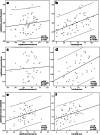Microbial neoformation of volatiles: implications for the estimation of post-mortem interval in decomposed human remains in an indoor setting
- PMID: 33026504
- PMCID: PMC7782407
- DOI: 10.1007/s00414-020-02436-4
Microbial neoformation of volatiles: implications for the estimation of post-mortem interval in decomposed human remains in an indoor setting
Abstract
The objective of this study was to determine if a relationship between microbial neoformation of volatiles and the post-mortem interval (PMI) exists, and if the volatiles could be used as a tool to improve the precision of PMI estimation in decomposed human remains found in an indoor setting. Chromatograms from alcohol analysis (femoral vein blood) of 412 cases were retrospectively assessed for the presence of ethanol, N-propanol, 1-butanol, and acetaldehyde. The most common finding was acetaldehyde (83% of the cases), followed by ethanol (37%), N-propanol (21%), and 1-butanol (4%). A direct link between the volatiles and the PMI or the degree of decomposition was not observed. However, the decomposition had progressed faster in cases with microbial neoformation than in cases without signs of neoformation. Microbial neoformation may therefore act as an indicator of the decomposition rate within the early decomposition to bloating stages. This may be used in PMI estimation based on the total body score (TBS) and accumulated degree days (ADD) model, to potentially improve the model's precision.
Keywords: 1-Butanol; Acetaldehyde; N-Propanol; Neoformation of ethanol; Post-mortem interval; Total body score.
Conflict of interest statement
The authors declare that they have no conflict of interest.
Figures




Similar articles
-
The frequency of ethanol, higher alcohols and other low molecular weight volatiles in postmortem blood samples from unnatural deaths.Forensic Sci Int. 2022 Dec;341:111503. doi: 10.1016/j.forsciint.2022.111503. Epub 2022 Oct 20. Forensic Sci Int. 2022. PMID: 36283278
-
Quantifying human decomposition in an indoor setting and implications for postmortem interval estimation.Forensic Sci Int. 2018 Feb;283:180-189. doi: 10.1016/j.forsciint.2017.12.026. Epub 2017 Dec 20. Forensic Sci Int. 2018. PMID: 29306148
-
Toxic volatiles in alcoholic coma. A report of simultaneous determination of blood methanol, ethanol, isopropanol, acetaldehyde and acetone by gas chromatography.Bull Los Angeles Neurol Soc. 1968 Jul;33(3):140-4. Bull Los Angeles Neurol Soc. 1968. PMID: 5669497 No abstract available.
-
Biochemical pathways generating post-mortem volatile compounds co-detected during forensic ethanol analyses.Forensic Sci Int. 2008 Jan 30;174(2-3):133-51. doi: 10.1016/j.forsciint.2007.03.018. Epub 2007 Apr 23. Forensic Sci Int. 2008. PMID: 17452087 Review.
-
Determinations of free and bound ethanol, acetaldehyde, and acetate in human blood and urine by headspace gas chromatography.Nihon Arukoru Yakubutsu Igakkai Zasshi. 1998 Jun;33(3):200-9. Nihon Arukoru Yakubutsu Igakkai Zasshi. 1998. PMID: 9701997 Review.
Cited by
-
Identifying the transition from ante-mortem to post-mortem odor in cadavers in an outdoor environment.Forensic Sci Int Synerg. 2025 Jun 11;11:100616. doi: 10.1016/j.fsisyn.2025.100616. eCollection 2025 Dec. Forensic Sci Int Synerg. 2025. PMID: 40551813 Free PMC article.
-
"Not everything that can be counted counts" in ethanol toxicological results: an antemortem and postmortem technical interpretation focusing on driving under the influence.Forensic Sci Res. 2024 Apr 2;9(3):owae023. doi: 10.1093/fsr/owae023. eCollection 2024 Sep. Forensic Sci Res. 2024. PMID: 39006154 Free PMC article. Review.
-
Ethanol and Higher Alcohols' Production in Fungal and Bacterial Laboratory Cultures and Significance for Forensic Samples.Microorganisms. 2024 Feb 24;12(3):462. doi: 10.3390/microorganisms12030462. Microorganisms. 2024. PMID: 38543513 Free PMC article.
-
Unusual concentration of tramadol detected in cadaver in the last stage of decomposition and in fly larvae in the immediate vicinity: case report and literature review.Forensic Sci Med Pathol. 2024 Mar;20(1):183-188. doi: 10.1007/s12024-023-00597-3. Epub 2023 Mar 9. Forensic Sci Med Pathol. 2024. PMID: 36892807 Review.
-
A review of multi-disciplinary decomposition research and key drivers of variation in decay.Int J Legal Med. 2024 Sep;138(5):2181-2192. doi: 10.1007/s00414-024-03222-2. Epub 2024 Apr 16. Int J Legal Med. 2024. PMID: 38622312 Free PMC article. Review.
References
-
- Carter DO (2020) The importance of microbial communities in the estimation of the time since death. In: Hayman J, Oxenham (eds) Estimation of the time since death. Current research and future trends. Academic Press, Elsevier Inc, pp 109–139
MeSH terms
Substances
LinkOut - more resources
Full Text Sources

